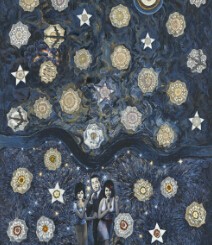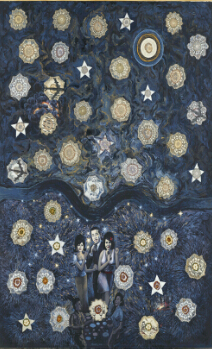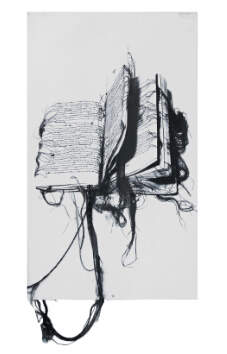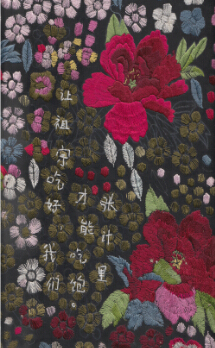[Press release]
Three years later in Hangzhou, a modern Chinese city, rich with its prolonged traditions in culture, leisure and silk production, 2016 will see the Second Hangzhou Triennial of Fiber Art. Beginning in 2013, the Triennial will once again inaugurate an international conversation from the fiber art’s perspective. On a large spatial and chronological scale, the conversation is based on history, humanity, life and social practices of today, environment, the internet, science and new technology.
This time, “weaving” is the concept of the Triennial exhibition, a starting point for curators and artists.
“Weaving” is a special labour mode. It becomes a narration, scrutinizes the historical presentation of textiles, and also illuminates our own experience with just materials and technology. With the pace of new technology and knowledge in this field, the perceptions of us weavers changes, too. By “us,” it means not only individuals but all groups and regions are involved in this practice.
Based on the theme Weaving & We, the exhibition combines relevant social aspects, such as local regions and industries. The exhibition includes four sections of curators’ research and artists’ works, echoing the theme from various dimensions.
Needles & proverbs
Needles can also serve the function of languages. In traditional Chinese, the character of “needle” has the same pronunciation as the character that means “admonition.” Therefore, in Chinese, the word needle shares the meaning of admonition without implication of gender. Whether the long bamboo needle for weaving and knitting, or the crewel needle for embroidery, needles all have the metaphor of admonition. Both in Chinese and western cultures, fine needles are connected to languages. It represents the sensation of human body, the activation and revival of humanity, the cultivation and self-reflection of soul, and a prophesy of the future.
Body & identity
The concepts of weaving and human body are intertwined; textiles of different materials, including wool, hemp, silk, and cotton, give us unique and special body sensations. Weaving is not only a body protection but also serves as a symbol of identity. Our physical body not only indicates temperature, feelings and identity, but also stands for memory and history. Today, in a multicultural era, textiles have another function—a symbol of identity of different races and regions, showing the distinction of different times and groups.
Weaving & form
Weaving could be seen as two-dimensional fabric making and as an approach of three-dimensional shaping. As a different type of shaping of a figure, weaving displays the techniques and the experimental characteristics of modern fiber art. It has inspired a series of conceptual transformations and become related with social reality. The meaning of weaving not only represents the behavior of weaving or creating a certain shape, but also contains the concepts of “constructing,” “building” and “perspective,” and involves many social factors.
Scene & phenomenon
The manufacturing process of weaving is a vivid and important social scene. Weaving originated from households, developed in workshops, transformed in local places, and was activated in factories. Weaving raises many questions for people to think about and drives us to find answers in our social reality. There is plenty of information from the local and people in the scene: weaving not only presents the individual workers, but is also based on industry, enterprises and groups, developed in the specific daily scenes, reflecting numerous social realities.
The Triennial will also include four specific units: Social Fabric is a collaborative project with British curator Grant Watson, supported by Institute of International Visual Art, London. Education history project Occurrence and Prosperity: Fiber Art Education in Poland between 1950 and 1980 is a collaborative project with curator Michal Jachula from Warsaw. And two projects about China: The Story of Embroidery: How Small Skill of Needlework Enters the History of Painting, including Song Embroidery -Xiu Pu, (The Principles and Stitchings of Chinese Embroidery) by Ding Pei-Zhenhu, and The story of Liang Xuefang and her mother who are both embroiderers from Zhenhu, Suzhou; Peony on Textile in China, based on the psychological impressions and memories of peonies, their use and transformations from Chinese people to our daily life and culture.
“Textile Thinking”: international symposium/lectures
Co-organizer: Mill6 Foundation
In the Triennial’s program this time will be an international symposium with the theme “Textile Thinking.” Professor Sarat Maharaj, an internationally-known curator and famous scholar in this field, will be the main speaker at the event. Professor Maharaj is invited to give the keynote speech “Thinking Through Textiles,” and this is the first time for him to present a talk on this theme in the exhibition of such stage in Asia. Maharaj’s research and writing on textiles can be dated back to the 1980s. He views artists’ works as knowledge production through textiles.
The series of seminars invites curators from international museums and foundations to discuss the contexts and significance of modern fiber art in museum collection. Other seminars include “Fiber Art Sketches: China Experiences” hosted by young Chinese curators and researchers Xu Jia, Zhang Yuling and Chen Haoru. During the exhibition period, will hold also several artists talks and lectures.
Solo exhibition
Liang Shaoji: Cloud above Cloud
Liang Shaoji’s solo exhibition, Cloud above Cloud will be hosted at the same time with the Triennial in the halls of Museum of China Academy of Art. For the first time he, an early graduate from China Academy of Art, will hold an exhibition in his Alma Mater. Taking life as core and living creatures as media, Liang’s works are renowned for interactions with nature.
International workshop “World Wide Weaving”—Seed Bank of Crafts
“World Wide Weaving” is an arena for investigation. It will be held after the opening of Hangzhou Triennial. This time in collaboration with the Fiber Art Department of China Academy of Art and Department of Textile Art of Oslo Academy of Art.




